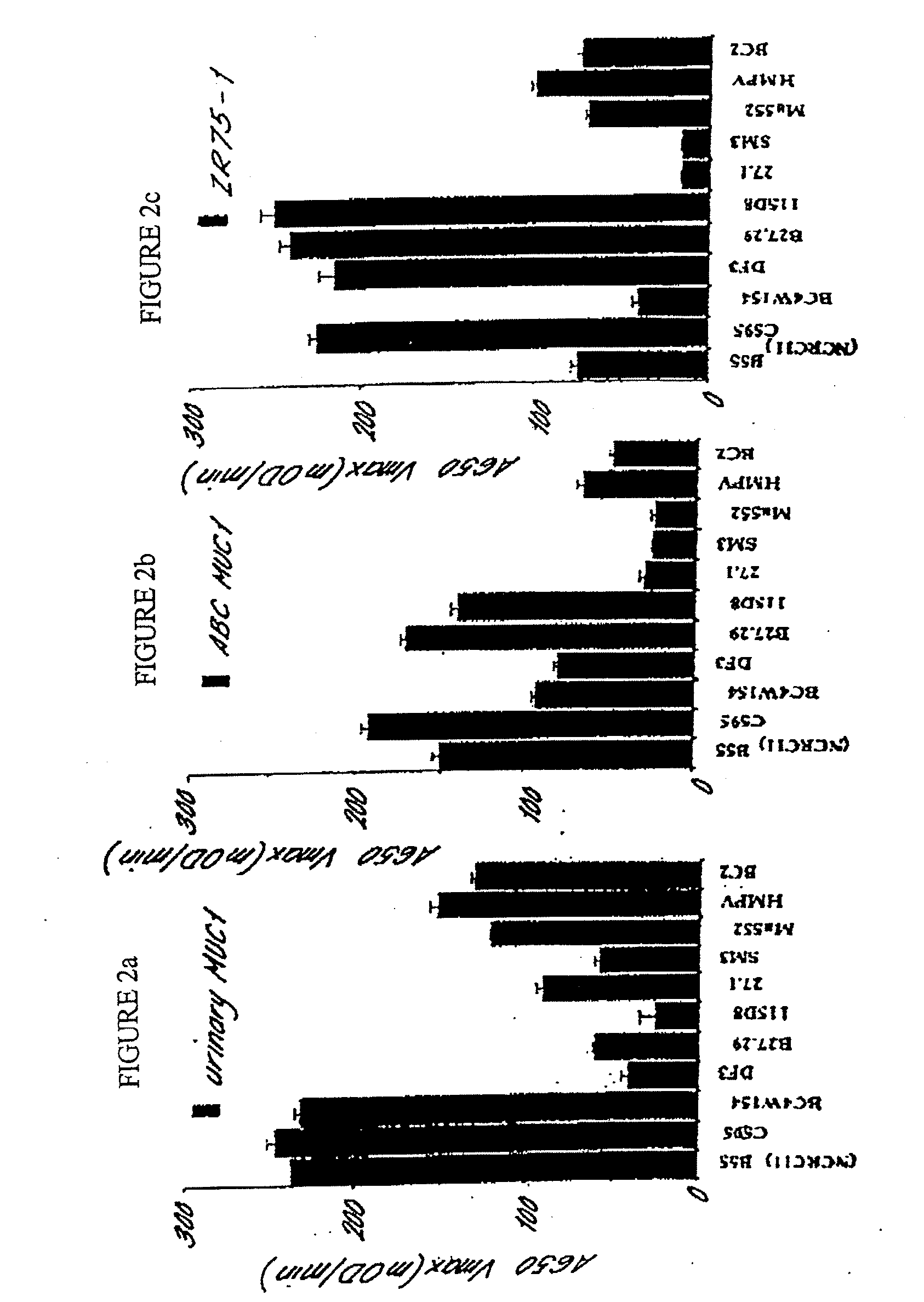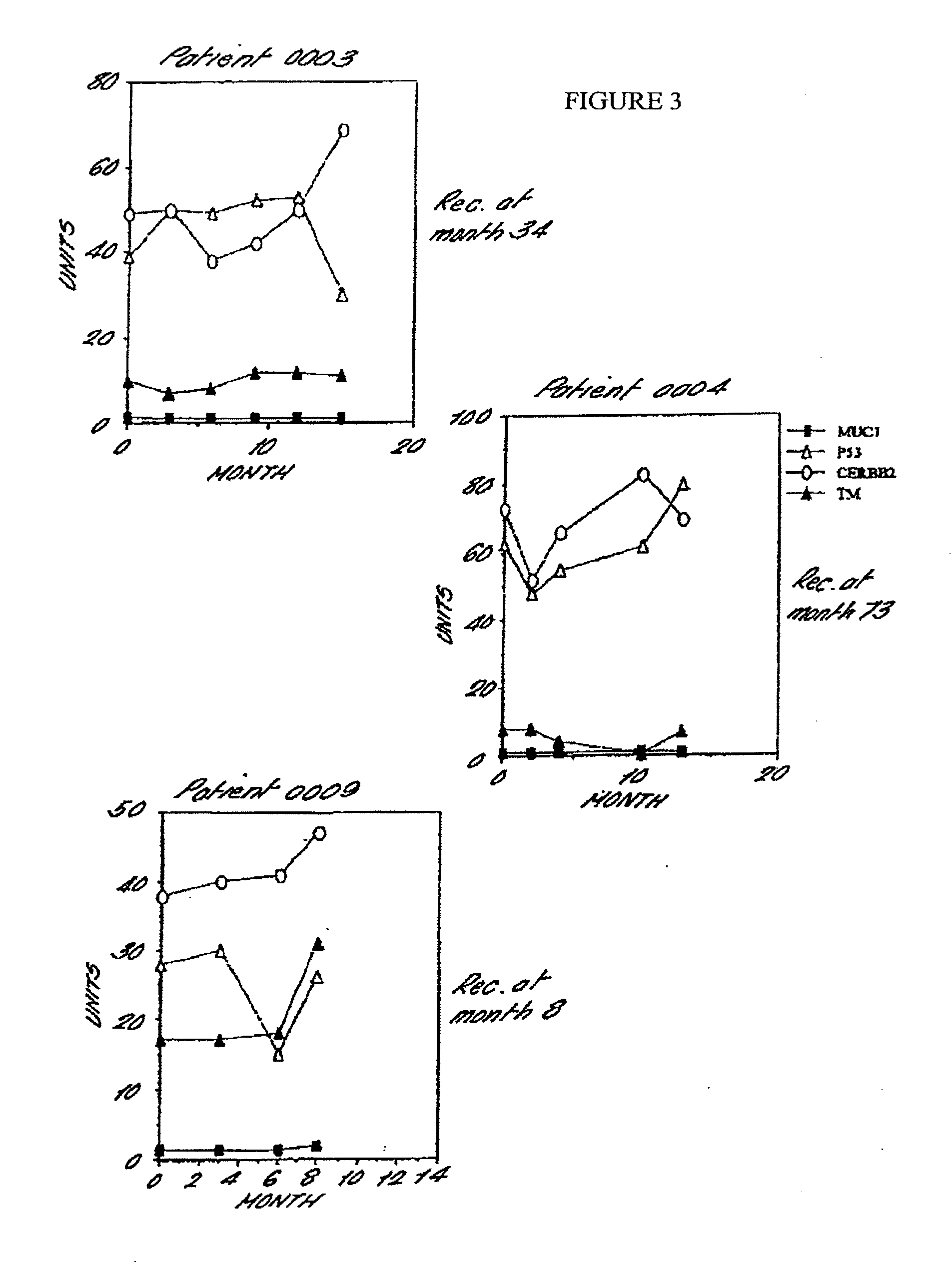Cancer Detection Methods and Reagents
a technology of immunological reagents and reagents, applied in the direction of snake antigen ingredients, instruments, viruses, etc., can solve the problems of insufficient detection accuracy of commercial antibodies used in standard insufficient detection accuracy and insufficient sensitivity of commercial antibodies used in standard tests to detect antigens, etc., to achieve the effect of improving the individual sensitivity of each assay
- Summary
- Abstract
- Description
- Claims
- Application Information
AI Technical Summary
Benefits of technology
Problems solved by technology
Method used
Image
Examples
example 1
Isolation of ABC MUC1 from Advanced Breast Cancer Patients
Method
[0222]ABC MUC1 was purified from pooled sera taken from 20 patients with advanced breast cancer using immunoaffinity chromatography as follows:
[0223]The mouse monoclonal anti-MUC1 antibody B55 (also known as NCRC 11 and described by Ellis et al. (1984) Histopathology. 8: 501-516 and in International patent application No. WO 89 / 01153) was conjugated to CNBr-sepharose beads. Pooled sera from patients diagnosed with advanced breast cancer was diluted 1 / 10 in phosphate buffered saline (PBS) and then incubated with the antibody conjugated sepharose beads (25 ml diluted sera to 1 ml packed volume of beads) overnight at 4° C. with rolling. The beads were then packed by centrifugation and the supernatant removed. In order to wash away unbound serum components the beads were resuspended in PBS, rolled for 10 minutes, packed by centrifugation and the supernatant removed. This washing sequence was repeated 5 times (or until A28On...
example 2
Immunological Characterisation of ABC MUC1 Isolated from the Serum of Patients with Advanced Breast Cancer
[0224]ABC MUC1 isolated from the serum of at least 20 patients with advanced breast cancer according to the procedure described in Example 1 can be distinguished from MUC1 isolated from the urine of normal human subjects (normal human urinary MUC 1) on the basis of altered affinity for the following mouse monoclonal anti-MUC1 antibodies:
B55 (NCRC 11)C595BC4W154Obtainable from Hybritech, IncDF3Obtainable from CentocorB27.29Obtainable from Biomira, Inc115D8Obtainable from Centocor27.1Obtainable from Austin Research InstituteSM3Obtainable from the Imperial Cancer ResearchFundMa552Obtainable from CanAgHMPVObtainable from Austin Research InstituteBC2Obtainable from Austin Research Institute
[0225]Normal urinary MUC1 is available from Dr M. R. Price, Cancer Research Laboratories, The University of Nottingham, University Park, Nottingham. NG7 2RD, United Kingdom.
[0226]The affinity of ea...
example 3
Cloning of Biotinylated p53
Method
[0227]Commercially available cDNA for p53 (E. coli clone pBH53, deposited in the American Type Culture Collection under accession number 79110) was cloned into the PinPoint™ plasmid vector (Promega Corporation, Madison Wis., USA) using standard molecular biology techniques. The PinPoint™ vector is designed to facilitate the production of fusion proteins comprising a biotinylation domain (consisting of a fragment of a biotin carboxylase carrier protein) fused N-terminally to the target protein of interest. Care was therefore taken during the cloning procedure to ensure that the reading frame of p53 was maintained in the fusion protein. Procedures for cloning in PinPoint™ vectors are described in detail in the Promega Protocols and Applications Guide obtainable from Promega Corporation, Madison Wis., USA.
[0228]Fusion proteins expressed from the PinPoint™ vector in E. coli are biotinylated by an enzyme system of the E. coli host cells and may therefore ...
PUM
| Property | Measurement | Unit |
|---|---|---|
| Volume | aaaaa | aaaaa |
| Fraction | aaaaa | aaaaa |
| Fraction | aaaaa | aaaaa |
Abstract
Description
Claims
Application Information
 Login to View More
Login to View More - R&D
- Intellectual Property
- Life Sciences
- Materials
- Tech Scout
- Unparalleled Data Quality
- Higher Quality Content
- 60% Fewer Hallucinations
Browse by: Latest US Patents, China's latest patents, Technical Efficacy Thesaurus, Application Domain, Technology Topic, Popular Technical Reports.
© 2025 PatSnap. All rights reserved.Legal|Privacy policy|Modern Slavery Act Transparency Statement|Sitemap|About US| Contact US: help@patsnap.com



